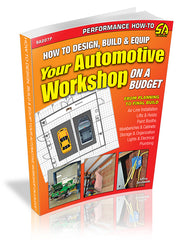Expert Interview: Automobile Lifts
by Jeffrey Zurschmeide
Jim Havlinek of Shop Equipment Company (www.shopequipmentcoinc.com) sells, installs, and inspects lifts for professionals and hobbyists. As someone who not only sells lifts, but also stands behind them and inspects them throughout their life, Jim has seen it all, and he has strong opinions about what to look for in an automotive lift. Interview conducted by Jeff Zurschmeide, author of How to Design, Build & Equip Your Automotive Workshop on a Budget.
Q: What’s your advice for automotive hobbyists who want to install a lift in their garage or workshop?
A: The main thing you’re looking for in an auto lift, whether it’s a hobbyist four-post, a standard four-post, or a two-post lift, is an ALI-ETL listing. [The ALI part stands for the American Lift Institute, which is made up of lift manufacturers, and includes people who import lifts from outside the United States. The ETL part stands for Environmental Testing Laboratory, which is an independent testing lab, like UL for electrical equipment.] They set up standards based on those from ANSI, the American National Standards Institute. The standards say what you should be able to test on a lift in order for it to be safe. ALI-ETL is working with OSHA to set the standards for lift safety, inspection, and certification. 
Q: Why are standards and certification important?
A: It all falls back on safety. You’re going underneath that hoist. The inexpensive Chinese-made lifts are crap. There are scary videos on the internet. They test a Chinese hoist and it blows apart. People have been killed trying to lift heavy vehicles with low-quality hoists, because they think the lift is strong enough to raise the vehicle, but it’s not. Also, the equalizer cables used in the safety system are often much smaller in the inexpensive imported hoists, and the pulleys are too small and damage the cables. When that happens, it’s a totally unsafe hoist and someone’s going to die or get injured. I tried the Chinese product—I brought in 6 hoists and they were the biggest warranty nightmare you can imagine.
Q: Can you put a two-post lift in a standard garage?
A: A standard slab is about 4 inches thick, but concrete can have a lot of variation in the way it handles stresses and loads. If the concrete sat in the truck before it was poured, it was trying to set up and cure. If the concrete sat there for two hours, I wouldn’t put a lift on it. It will develop cracks and then you’re just waiting for the day it’s going to fracture. For most garages you can use a four-post hobbyist lift. The other thing is that you can only lift so high in a standard garage before you hit the ceiling. If you have a crossover SUV or another tall vehicle and a 9-foot ceiling, you may only be able to lift the vehicle about 3 feet. Most four-post lifts require a 12-foot ceiling because they lift to 72 inches.
Q: What is there to know about the pads that the hoist uses to pick up a vehicle?
A: Take Chevy trucks for example—in 2006 they changed the undercoating to a new formula that’s flexible and slick. If you try to raise that truck with a standard steel flip-up pad, it can slip and fall off. There are special adapters available to address those situations. On other trucks, you want to raise them by the frame rails. But you then have a situation where the gas tank is right up against the frame rail, the brake lines are on the other side, and the standard pad’s going to hit one of those. So quality lift manufacturers offer a wide variety of specialized adapters to fit special needs.
Q: What is something to look for that buyers might not expect?
A: Direct-pull versus direct-push makes a big difference. Direct-pull lifts mount the hydraulic ram at the top of the column, so when it rises, it’s actually sucking the ram up into it. This is a big advantage because when you have a car up in the air, there’s no exposed chrome alloy shaft. You can weld or throw tools and there’s no way you’re going to damage the ram. With a direct-push, the ram is mounted upside down and it’s pushing out to lift a vehicle. Then the chrome alloy shaft is exposed when the vehicle is on the lift. The other thing is that a direct-push system has a tendency to walk because of the leverage as the vehicle rises, and that wears out components.
Q: What about hoist inspections?
A: Professional shops are required to have their lifts inspected once a year by an outside third party. Bolts come loose, parts bend, and lifts that are in use every day need to be inspected. It’s all about safety.
Q: Is there any other advice you have for lift buyers?
A: Get a few high stands—they’re a no-brainer. It’s just a tall stand that you can put under the vehicle. For example, if you have an older car like an MG or a Jeep and you’re under them torquing on stuff, you can flex it enough to lift one corner off the arm. So you use a high stand under the front or rear of the vehicle so that if you take weight off one end, it supports the other end so there’s no levering action. It’s the cheapest insurance you can buy. If you buy a hoist, the next thing you should think about buying is a set of high stands.
Euip your perfect garage with tips from this book, HOW TO DESIGN, BUILD & EQUIP YOUR AUTOMOTIVE WORKSHOP ON A BUDGET.
SHARE THIS ARTICLE: Please feel free to share this post on Facebook Groups or Forums/Blogs you read. You can use the social sharing buttons to the left, or copy and paste the website link: https://www.cartechbooks.com/blogs/techtips/expert-interview-buying-a-garage


